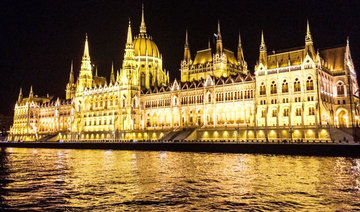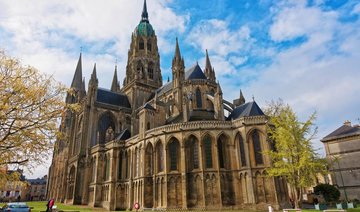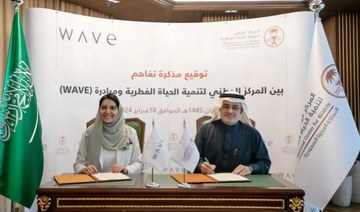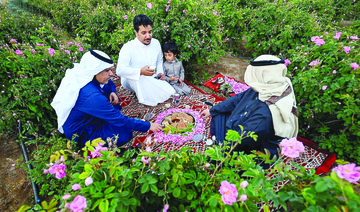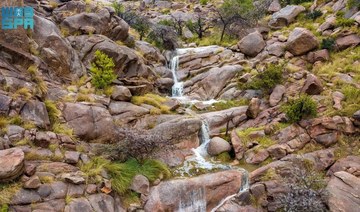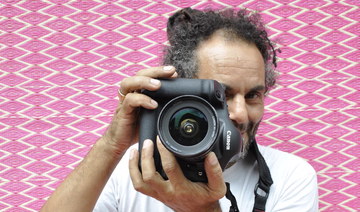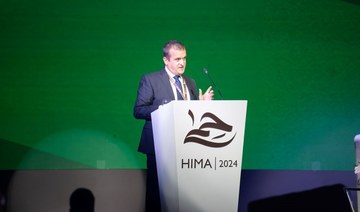BARCELONA: It was 80 years ago this summer that a wounded George Orwell was fortunate to escape Spain with his life.
The British author had arrived in Barcelona in December 1936, five months after the Spanish Civil War erupted, to join the government’s fight against Nationalist faction, whose army-led fascist rebellion had torn Spain asunder.
But it was not General Franco's forces from whom he fled — it was from his own side, the Republicans.
“Homage to Catalonia,” published in 1938, is Orwell’s account of his experiences and so lucid is his writing that it is easy to follow in his footsteps around what has become the tourist heart of Barcelona.
Once a niche activity among sightseers in the city — the third most visited in Europe and increasingly popular among Arab tourists — Orwell tours are in growing demand as a group of English expat guides help Spain recover a period of its history many would rather forget.
Orwell was among the 35,000 foreign volunteers who fought for the Republic in a civil war sparked by the army’s refusal to accept modest reforms to help Spain’s poor. More than 500,000 people died in the war.
On arriving in Barcelona, Orwell describes a city in which the “working class was firmly in the saddle” after anarchists formed an unlikely alliance with government forces to thwart the military uprising in Catalonia.
The social order was razed; about 2,000 businesses — including shops, factories and hotels — were collectivized as anarchists exploited enfeebled state authority to launch a revolution.
After rudimentary training, Orwell and his fellow militiamen were dispatched to the Aragon front, which was about 300 kilometers to the east. With fighting concentrated around Madrid and the south, Orwell’s biggest battle was against the cold and when he returned to Barcelona on leave in late April, the city was starkly different. Revolutionary fervor had dissipated and class distinctions of wealth and privilege were reappearing.
“Under the seeming gaiety of the streets, with their flower-stalls, their many-colored flags, their propaganda-posters and thronging crowds, there was an unmistakable and horrible feeling of political rivalry and hatred,” Orwell wrote in Homage to Catalonia.
“People of all shades of opinion were saying forebodingly: ‘There’s going to be trouble before long.’ The danger was quite simple and intelligible. It was antagonism between those who wished the revolution to go forward and those who wished to check or prevent it —ultimately, between anarchists and communists.”
Aided by Hitler’s Germany and Mussolini’s Italy, Franco’s forces swiftly captured more than half of Spain’s landmass, although by mid-1937 the major cities of Madrid, Valencia and Barcelona remained free.
Tit-for-tat murders stoked tensions in Barcelona, but that only forestalled the violence that would claim about 500 lives in less than a week.
On May 3, the communist-run Assault Guards stormed Barcelona’s telephone exchange in Plaça de Catalunya, which was under anarchist control. As word spread that worker-held buildings were under attack, armed anarchists took to the streets, fighting erupted and barricades were hastily built from cobblestones as myriad groups defended their turf.
Orwell was walking down La Ramblas, Barcelona’s most famous street and one that runs south from Plaça de Catalunya, when he heard gun shots crackle around him. He turned and saw rifle-wielding anarchist youths, their red and black handkerchiefs around their throats, edge up Carrer de Sant Pau, a side road off the main thoroughfare, to return fire at the Assault Guards who were shooting indiscriminatingly from the octagonal church tower of the Santa Maria del Pi.
Orwell fled to Hotel Falcon on La Ramblas, which today is the Biblioteca Gotic library. At the time, it was a boarding house for members of his militia, The Workers' Party of Marxist Unification (POUM).
Assault Guards seized Café Moka, situated 700 meters north on La Ramblas, which still operates under the same name. They were preparing to storm the POUM newspaper office next door, which today is the Hotel Rivoli. Orwell manned the roof of the Cinema Poliorama opposite, now a theatre, to deter the attack and he remained there for three nights until the fighting ended.
On May 7, heavily-armed reinforcements arrived from Valencia, the temporary seat of Spain’s legitimate government, enabling the state to reassert its control over the city.
Orwell soon returned to the trenches of Aragon, where a few weeks later he was shot through the throat by a sniper. He was shunted between hospitals in Catalonia’s hinterland, before arriving at Barcelona’s Sanatorium Maurín.
Barcelona’s atmosphere was toxic, tension heightened by expectations that street-fighting would resume.
“There were times when I caught my ears listening for the first shots. It was as though some huge evil intelligence were brooding over the town,” Orwell wrote. “Everyone noticed it and remarked upon it. And it was queer how everyone expressed it in almost the same words: ‘The atmosphere of this place — it’s horrible. Like being in a lunatic asylum’.”
Orwell decided to leave Spain and spent five days near the front obtaining discharge papers, returning to Barcelona around June 23. Unknown to him, the POUM had been outlawed and he was now a fugitive from the Republic government he had come to Spain to fight for.
Helped by the British Consulate, Orwell and his wife obtained the necessary papers to leave and fled by train to France in 1937.
In his writings, Orwell lambasts Soviet Russia for pushing Spain’s government to crush the nascent revolution and then for pretending it ever existed, arguing this ultimately led to its defeat. Orwell warned against his own bias and mistakes, admitting it was impossible to be entirely objective and 80 years later, his work is under scrutiny.
“Homage to Catalonia is probably the most bought and read book on the Spanish civil war and, because it only deals with a tiny portion of the war and yet makes very sweeping conclusions, it has had a toxic effect on the thinking about the Spanish Civil War,” Paul Preston, a world-authority on 20th century Spanish history, told Arab News.
The war shaped Orwell’s thinking in writing “1984,” a satire on totalitarianism published in 1949 in which the main protagonist works for the Ministry of Truth, rewriting history.
“What impressed me then, and has impressed me ever since, is that atrocities are believed in or disbelieved in solely on grounds of political predilection,” Orwell wrote. “The truth, it is felt, becomes untruth when your enemy utters it.”
In writing “1984,” Orwell created phrases and ideas that have entered the public consciousness such as “Big Brother” and “Room 101.”
Without his experience in Spain, this seminal book may never have been written.
“Homage to Catalonia was the genesis of everything he hated about totalitarianism and was the genesis of both ‘Animal Farm’ and ‘1984’,” Richard Blair, Orwell’s adopted son, told Arab News.
“When he got back to Barcelona after being wounded he discovered he was being hunted and I think that’s where he suddenly realized what totalitarianism was all about.”
Take a self-guided tour
Visitors hoping to follow in Orwell’s footsteps can take in all the main sights with a 1.2 kilometer stroll starting at Plaça de Catalunya, the sprawling square at the top of La Ramblas and the emotional center of Barcelona. On the north side is the present-day Apple shop where, during the Civil War, the Hotel Colon stood. This hotel was seized by Catalonia’s Communist party (PSUC) as its headquarters.
At the most easterly point of the square, where Avengida del Portel de l’Angel meets Carrer de Fontanella, lies the Mobile World building.Then a telephone exchange controlled by the anarchist union CNT, the Catalan police stormed this building, sparking the Barcelona bloodbath Orwell describes in Homage to Catalonia.
Next, you should head to La Ramblas, the city’s most famous street, which begins at Plaça de Catalunya’s southerly point.
Just a few doors down from the El Cortes Ingles department store, on the left-hand side, is the Hotel Continental, where Orwell’s wife, Eileen Blair, was staying when the author became a hunted man.
Then, walk 160 meters further down La Ramblas to Café Moka, which Assault Guards seized ahead of an expected attack on the POUM’s newspaper office next door. Today, it is the Hotel Rivoli. Opposite is a modern-day theater, once known as the Cinema Poliorama, where Orwell was stationed for several days to provide sniper protection for the newspaper office below.
Next, walk for another 400 meters until you see Carrer de Sant Pau to your right. It was from this side street that Orwell witnessed a gun battle between anarchists at ground level and Assault Guard snipers positioned in the octagonal church tower of Santa Maria del Pi, which will be to your left, on the opposite side of La Ramblas.
A further 350 meters south is the Biblioteca Gothic-Andre Nin, named after POUM’s leader. In 1937, this building was Hotel Falcon, a boarding house for POUM militiamen.
See Barcelona through George Orwell’s eyes
See Barcelona through George Orwell’s eyes
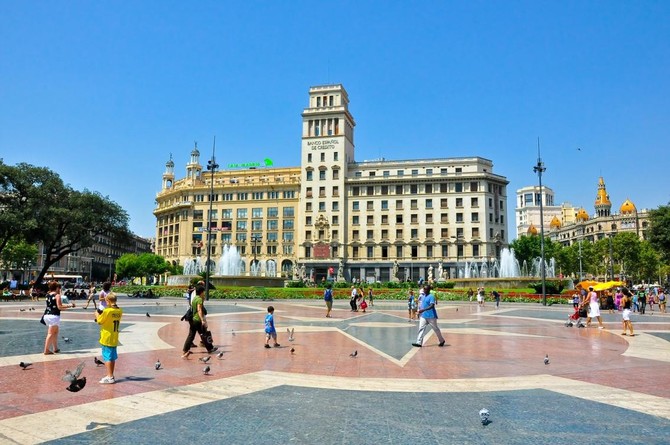
Riyadh conference to explore museum innovation

- The winning team will earn a week-long educational trip to London, which will include expert-led museum tours and lectures
RIYADH: Saudi Arabia’s Museums Commission is to host the International Conference on Education and Innovation in Museums, in Riyadh, from June 1 to 3, to help boost the sector in the Kingdom and beyond.
Leading museum professionals and educators will convene for knowledge exchange and collaboration, exploring best practices in museum education; the role of museums in fostering creativity and learning; and opportunities for international collaboration.
The three-day event will feature expert-led sessions, including panel discussions, workshops, and research paper presentations, addressing current museum issues and topics such as collaboration between museums and universities; beyond the textbook for active learning; beyond the museum walls for public engagement; and design thinking and innovation in museum management.
Additionally, the conference will host a competition in which participating teams will develop innovative solutions to enhance visitor engagement and museum experiences.
The winning team will earn a week-long educational trip to London, which will include expert-led museum tours and lectures.
Registration for the competition closes on May 25.
Wildlife center to explore caves in Saudi Arabia’s north

- The program to explore biodiversity in caves was launched “due to its environmental significance and positive impact on wildlife”
RIYADH: Teams from Saudi Arabia’s National Center for Wildlife will begin examining various caves in the Northern Borders region as part of the Caves Exploration Program, which began in 2022.
It comes as part of a larger program that monitors ecosystems and biodiversity throughout the Kingdom.
These sites will be added to an international map of biodiversity and natural heritage hotspots as historical ecosystems and natural biological museums.

Dr. Mohammed Ali Qurban, CEO of the center, explained that the discoveries in the caves hold significant historical environmental value for Saudi Arabia.
“The cave ecosystems serve as a historical museum, providing evidence of the biological diversity that has existed in the Kingdom throughout various historical eras, as well as the spatial, environmental, and climatic changes in the Arabian Peninsula,” he explained.
The cave ecosystems serve as a historical museum, providing evidence of the biological diversity that has existed in the Kingdom throughout various historical eras.
Dr. Mohammed Ali Qurban, National Center for Wildlife CEO
Qurban added that these unique ecosystems provide a suitable environment for a wide range of organisms, as evidenced by the discovery of numerous skeletons of different types of mammals.
The program to explore biodiversity in caves was launched “due to its environmental significance and positive impact on wildlife.”

The center is currently completing studies on the targeted cave sites and documenting their importance within an integrated program.
According to Qurban, the center’s earlier discovery of several Arabian cheetah mummies in a cave in the northern part of the Kingdom — with some skeletons estimated to be over 4,000 years old — provided the first evidence of the species’ presence in the Kingdom.
Consequently, the center plans to develop a program for the resettlement of the Arabian cheetah in the Kingdom, enabling it to play a crucial role in maintaining environmental balance.
Qurban noted that, among other significant discoveries, researchers from the center discovered rare bats and the remains of several extinct animals.
The center is currently working on classifying these finds and determining their ages. This effort will facilitate the resettlement of these extinct species or their closest genetic relatives, thereby restoring their role.
The cave ecosystem is one of the rarest and most important of its kind in the world, recognized as natural heritage by UNESCO.
There are 1,826 caves in the Kingdom, consisting of underground passages and tunnels formed by natural processes in dry limestone areas — evidence of a historical era that experienced prolonged rainy climatic conditions.
Baha’s quaint guesthouses offer a warm welcome

- Sharifa Al-Ghamdi, owner of Al-Ayed Heritage Guesthouse, revealed that she has worked hard over the years to acquire as many historic houses as possible to be able to give tourists an authentic taste of what life was like in the past
RIYADH: Al-Baha is a region of the Kingdom blessed with a rich legacy of ancient architecture, with heritage lodges playing a big role in luring tourism to the city.
According to the Saudi Press Agency, heritage lodges or guesthouses in the region play an important role in attracting more investment. They provide local and international visitors with a look into the past, a taste of a simpler time that many people long for.

The guesthouses are a reflection of the region’s heritage. Al-Baha’s residential buildings, castles and fortresses were designed to suit not just environmental variables such as topography and climate, but also social circumstances such as local customs and ancient traditions.
FASTFACTS
• Heritage lodges or guesthouses in the Baha region play an important role in attracting more investment.
• One of the most enticing elements of these heritage guesthouses is their deep connection with nature.
One of the most enticing elements of these heritage guesthouses is their deep connection with nature.

They are constructed using stones and trees from the region, typically granite and basalt boulders adorned with quartz, and roofed with mud-coated juniper trees.
Sharifa Al-Ghamdi, owner of Al-Ayed Heritage Guesthouse, revealed that she has worked hard over the years to acquire as many historic houses as possible to be able to give tourists an authentic taste of what life was like in the past.

She said that, with the assistance of her family, she was able to realize her lifelong dream and passion and invest her post-retirement time in establishing heritage tourist guesthouses.
She has transformed the old houses in her village from dilapidated structures into a tourist and environmental attraction for people in search of tranquility and relaxation.
All is rosy in Taif as fans flock to flower festival
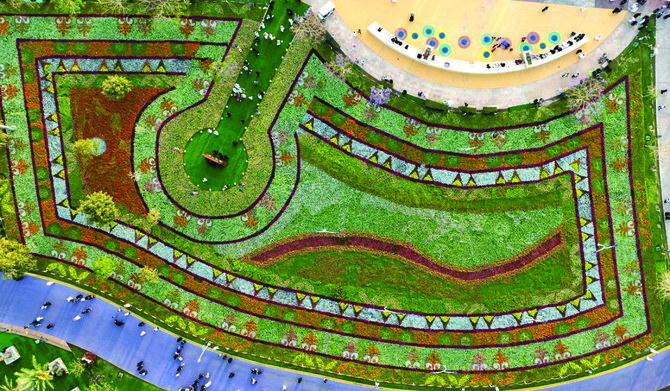
- Taif’s annual show features a floral carpet of over million flowers
- Farmers, vendors optimistic about increase in sales at the event
JEDDAH: Visitors are flocking to the 19th Taif Rose Festival at Al-Raddaf Park where the flowers are in full bloom, highlighting the region’s rich floral heritage.
The festival, themed “Qetaf” meaning “picking time,” coincides with the harvest season and will run until May 12. The organizers include the Taif Rose Cooperative Society and Taif Municipality.

There has been an impressive turnout of Taif residents and domestic and international tourists. The exhibitors — mostly farmers and vendors — are optimistic that increased revenues will help boost rose cultivation and production.
Abdullah Altwairqi, a local farmer and festival participant, said: “Participating in the Taif Rose Festival has become a tradition for me. The atmosphere improves each year, and the revenue and exposure we receive from visitors make it worthwhile.”
HIGHLIGHTS
• Exhibitors at the Taif Rose Festival are optimistic that increased revenues will help boost rose cultivation and production.
• The flower carpet set up by the municipality in the center of the park was designed with decorative patterns inspired by the province’s heritage.
• It covers 5,206 square meters and was crafted using over a million flower and rose seedlings, making it the largest in the history of the festival.
At his booth, Altwairqi showcased various flowers and fruit, including Taif roses, peaches, prickly pears, figs, mulberries, grapes, blackberries, pomegranates, as well as aromatic plants.

Altwairqi urged people to visit the Rose Flavor cafe where they can savor hot and cold beverages infused with the flavor of Taif roses and other aromatic flowers including lavender, which is also abundant in the region.
The flower carpet set up by the municipality in the center of the park left visitors awestruck. Covering 5,206 square meters, it was crafted using over a million flower and rose seedlings, making it the largest in the history of the festival.

Faiz Al-Thibaiti, director-general of media and corporate communication at Taif Municipality, told Arab News: “The flower carpet was designed with decorative patterns inspired by the province’s heritage.”
He said the carpet has ensured the event has become “one of the most important tourism festivals in the Kingdom, attracting thousands of visitors and tourists from various regions of the country.”
NUMBER
70k
The rose-picking season in Taif starts around the end of March or early April, lasting between 35 to 45 days, with an average of 70,000 roses picked daily.
The decorations adorning the flower carpet draw inspiration from the intricate designs found on the walls and facades of Taif’s ancient structures, including Al-Kaki Palace in Al-Salama and King Saud Palace.

Al-Thibaiti added: “Preparations for the festival started early, with the Taif Rose Cooperative Society detailing participation criteria to highlight Taif roses, including their cultivation, harvesting, and distillation into fine perfumes. This adds to Taif’s unique tourist appeal. The festival provides a platform for producers, experts, and entrepreneurs to connect, collaborate, and boost this important sector.”
Among the highlights are the rose and flower path, product stalls, goods market, government booths, and the agricultural nursery.
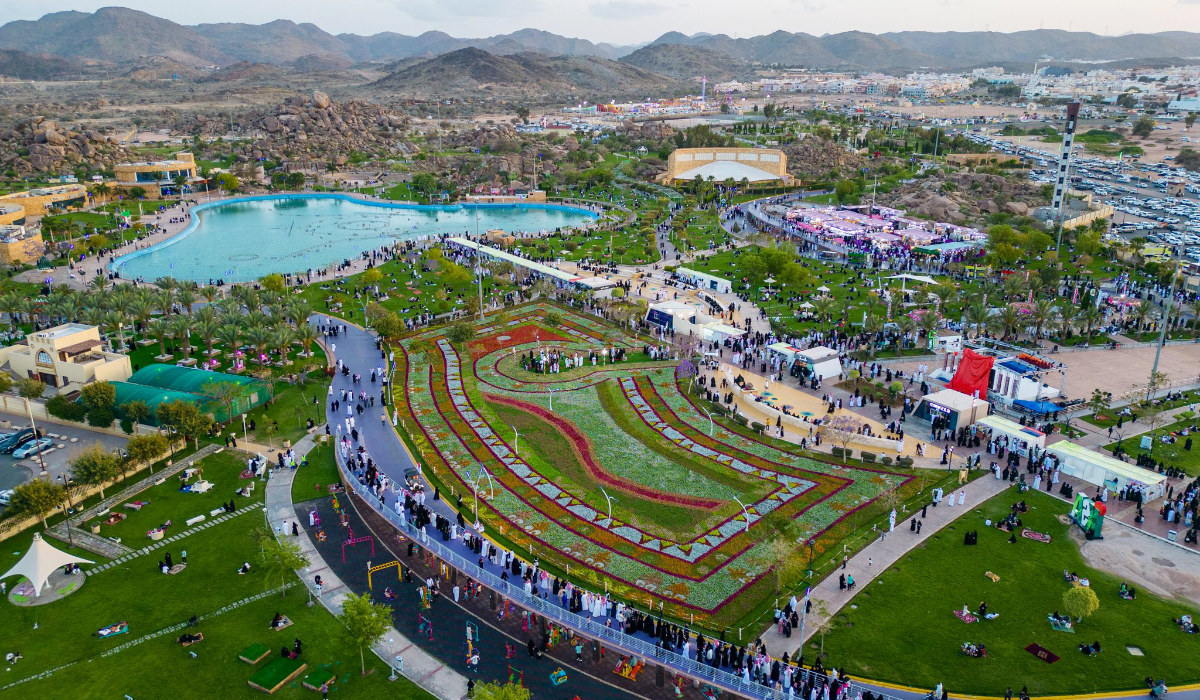
Interactive fountain shows accompanied by national tunes were also among the attractions, with a crossing to the upper pedestrian bridge from where visitors can view the massive flower carpet.
Artwork, flower arrangements, and hanging floral baskets scattered throughout the park added to the flair of the event.
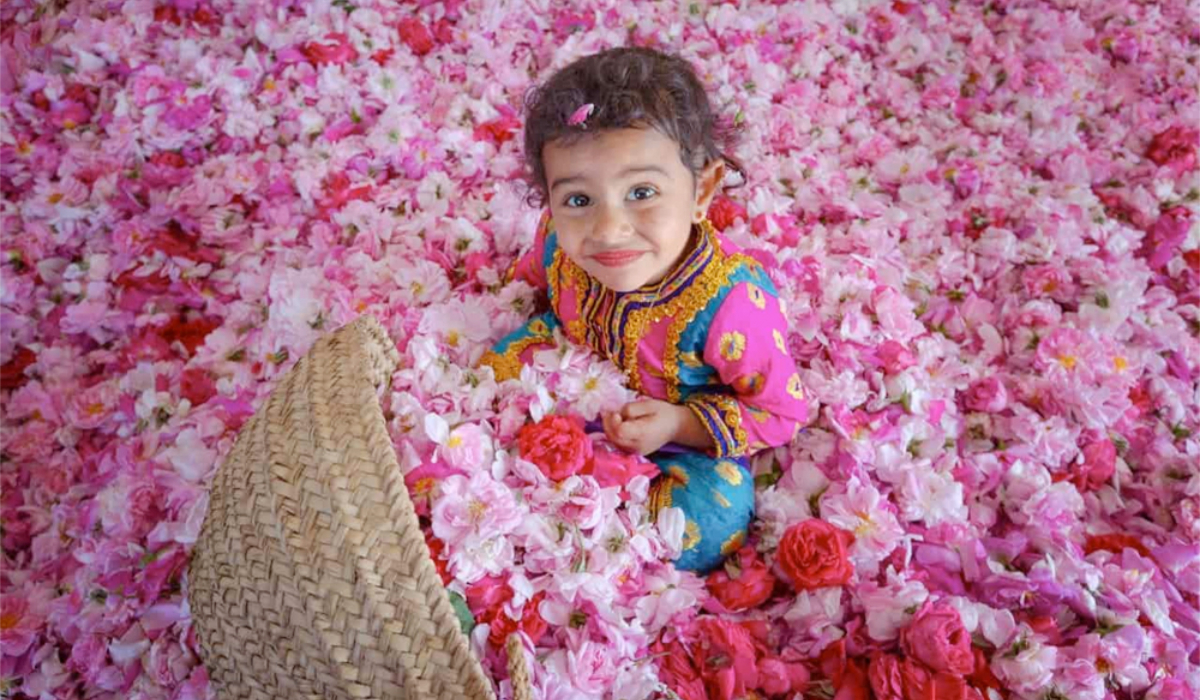
Al-Thibaiti said: “The significant turnout at the current festival comes amid increasing rose production year after year, indicating the success of this agricultural sector in achieving high revenues while continuing to promote the Taif rose product.”
Taifrosethon
The five-day Taifrosethon began on May 7, which is being held to encourage entrepreneurship in the region with technological solutions to enrich the industry.
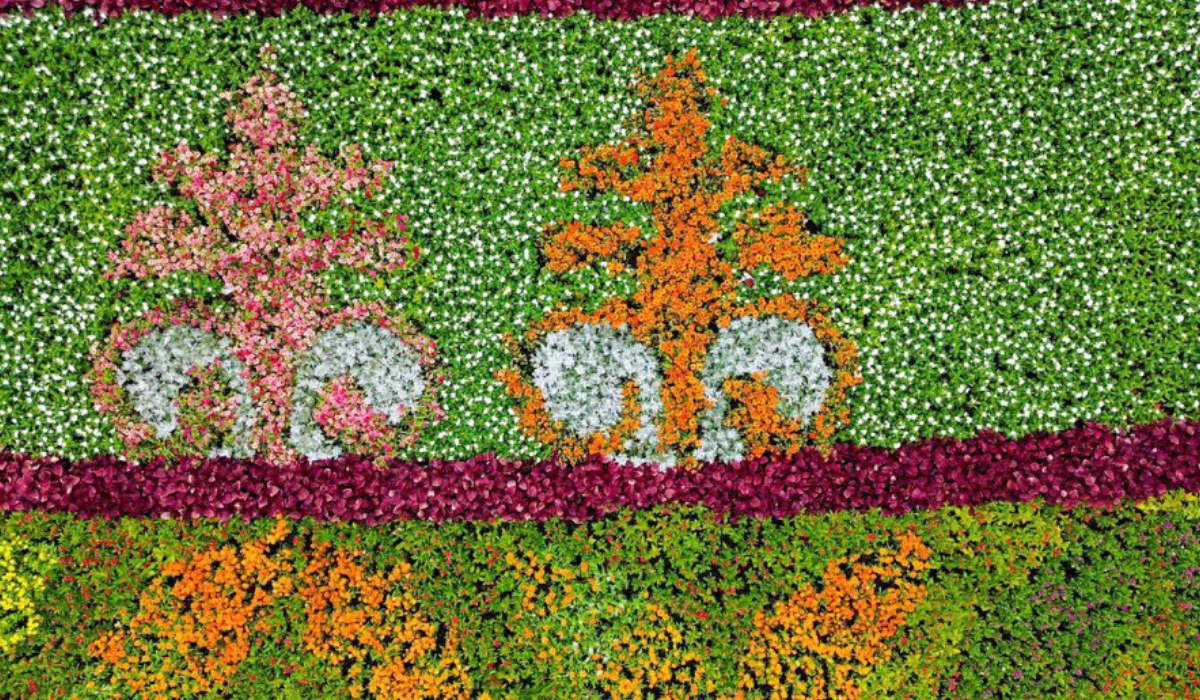
The event includes various skills training and technical workshops covering trade, cultural heritage, and tourism.
The top-three winners will receive $2,666, $1,866 and $1,333 respectively. Participants are required to enter as teams, each with three to five members.
Taif’s roses
The Taif province produces more than 200 million roses each season. According to the local chamber of industry, each tree produces an average of 250 roses daily throughout the harvest season, which lasts for about 45 days.
The rose-picking season starts around the end of March or early April, lasting between 35 to 45 days, with an average of 70,000 roses picked daily.
Taif roses feature an exquisite, sweet fragrance and vibrant pink hues on delicate petals, and are a hallmark of the region’s natural beauty.
Cultivated in the high-altitude climate of Taif, these roses thrive in the cool temperatures and fertile soil of the region.
They are meticulously harvested by hand to preserve their quality, with the petals carefully collected for various purposes.
AlUla Academy aims to be hub for tourism vocational training in Saudi Arabia and beyond
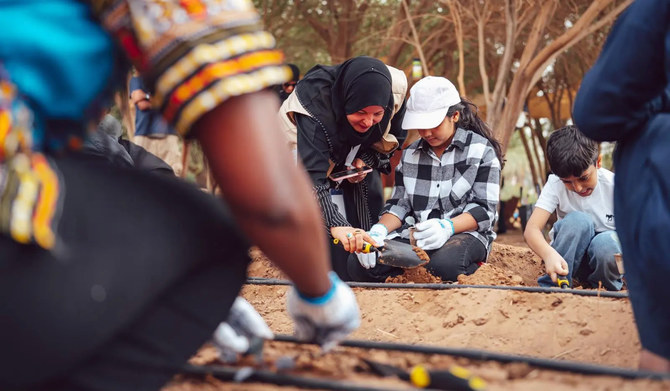
- Hotel.School chosen as global partner for hospitality training and the academy will welcome its first group of students in early July
ALULA: The Royal Commission for AlUla on Tuesday officially launched AlUla Academy, described as a pioneering initiative that aims to be a beacon across the region for excellence in vocational training in the tourism sector.
It will serve as a global hub, officials said, for workers directly involved in crafting memorable experiences for diverse groups of visitors to AlUla from around the globe.
Hotel.School has been chosen as the academy’s global partner for hospitality training, and the collaboration will begin with an inaugural digital training program for the first group of students in early July. Subsequent programs will be available through the academy’s website.

Authorities in the Kingdom are carefully developing historic AlUla, an ancient oasis in the northwest of the Arabian Peninsula, as a global tourist destination distinguished by its 7,000-year-plus history, spanning several civilizations.
It encompasses four primary heritage sites and a wide selection of visitor experiences which, the Royal Commission said, offer tourists the chance to immerse themselves in the region’s rich heritage and culture, take advantage of its wellness offerings, bask in the beauty of nature, indulge in the arts, and embark on and voyage of discovery.

The establishment of the academy therefore stands as a pioneering endeavor within the field of tourism, it added, and a cornerstone of efforts to achieve the goals of the Kingdom’s Vision 2030 development and diversification plan, one of the aims of which is to create 1.3 million jobs for Saudi citizens.
Philip Jones, the Royal Commission for AlUla’s chief tourism officer, said: “Learning centers such as AlUla Academy play a pivotal role in creating job opportunities while upholding excellence in visitor experiences to international standards, all while maintaining an authentic Saudi essence.

“Both physically and digitally, AlUla Academy will expedite the training process, enhancing the quality and efficiency of professional skill development, thereby advancing the tourism sector’s goals in the Kingdom.”
The guests at the launch ceremony on Tuesday included Anita Mendiratta, special advisor to the UN secretary-general at the UN World Tourism Organization. Also a member of the Royal Commission’s advisory board between 2017 and 2023, and one of the key figures behind the development of the academy, she emphasized the organization’s steadfast commitment and dedication to the enhancement of visitor experiences through the development of local skills.
“The key to AlUla’s development lies in embracing authenticity and prioritizing community engagement,” Mendiratta said.
“The Royal Commission for AlUla understands that reaching tangible milestones necessitates investing in skill development, providing services with international standards, yet infusing them with the distinct essence of AlUla that echoes its environment, the culture of its people, and their profound history.”
Hotel.School was carefully chosen as a global partner for AlUla Academy, the commission said, following a rigorous selection process to identify the most suitable collaborator to bolster its endeavors and help achieve its objectives. To that end, it will offer intelligent educational solutions and collaborate with developers of cutting-edge technologies to provide a diverse array of online-learning experiences, officials said. Further information about courses, registration procedures and criteria for the selection of students will be available soon.
Adnan Sawadi, the acting director of Hotel.School, said the institution is committed to supporting the commission in its mission to achieve excellence in vocational training across AlUla, the Kingdom and the wider region.
“At Hotel.School, we recognize that the vitality of the hospitality sector is its people, and we take pride in our pivotal role in nurturing and developing the skills essential to fortifying AlUla’s position as a global tourism and hospitality hub,” he said.
“Our commitment extends to fostering an educational environment that resonates with the region’s rich heritage, amplifying its cultural significance on the global stage.”
AlUla has received significant acclaim and been described as a beacon of success in the field of tourism development and the enhancement of local skills, the commission said. It attracted 263,000 visitors in 2023 alone and consistently surpasses the targets set for it, officials said, increasingly bringing it to the attention of leading event organizers, investors, development partners, airlines and the international media.





